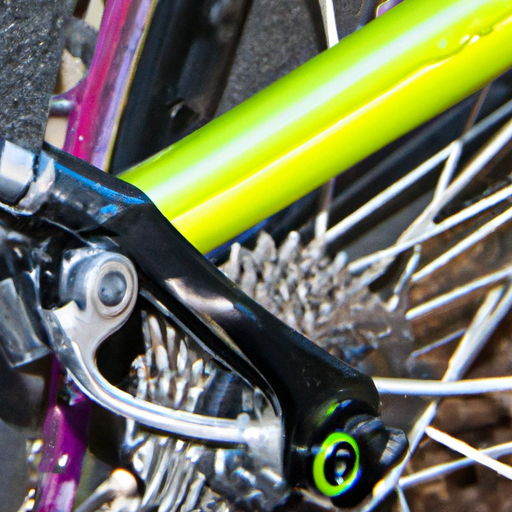What Is The Proper Way To Adjust My Suspension Settings?
Are you ready to take your ride to the next level? If you’ve ever wondered about the proper way to adjust your suspension settings, then this article is here to guide you. Whether you’re a casual rider or a seasoned enthusiast, getting your suspension dialed in just right can make all the difference in your overall riding experience. In this article, we’ll cover everything you need to know about adjusting your suspension settings, from the basics to the advanced techniques. So grab your wrench and let’s get started on optimizing your ride!
Choosing the Right Suspension Settings
When it comes to maximizing your bike’s performance and comfort, choosing the right suspension settings is crucial. Suspension settings refer to the various adjustments that can be made to your bike’s front and rear suspension components. These settings allow you to fine-tune your bike’s handling and responsiveness to suit your riding style, preferences, and the terrain you will be riding on. By understanding the purpose of suspension settings, determining your riding style and preferences, and considering the terrain and conditions you will be riding in, you can make informed decisions when it comes to adjusting your suspension.
Understanding the Purpose of Suspension Settings
Suspension settings play a vital role in how your bike performs on different types of terrain. They control how your bike absorbs impacts, how much travel your suspension has, and how quickly it returns to its original position after being compressed. By adjusting these settings, you can alter the behavior of your bike’s suspension to optimize performance and comfort.
Determining Your Riding Style and Preferences
Before diving into suspension adjustments, it is important to determine your riding style and preferences. Are you an aggressive rider who enjoys tackling challenging trails and jumps? Or are you more of a casual rider who prefers smooth and comfortable rides? Understanding your riding style will help guide your suspension adjustments. Additionally, considering your preferences, such as how soft or firm you want your suspension to be, will further assist in selecting the appropriate settings.
Considering the Terrain and Conditions
The type of terrain and conditions you will be riding in should also be taken into account when adjusting your suspension settings. Different terrains, such as rocky trails or smooth pavement, require different suspension setups to ensure optimal grip, stability, and maneuverability. Additionally, factors like temperature, humidity, and altitude can also affect your suspension’s performance. By considering these variables, you can adjust your suspension to suit the specific demands of the terrain and conditions you will be riding in.
Understanding Suspension Components
To effectively adjust your suspension settings, it is essential to have a basic understanding of the key suspension components. There are two main components involved in a bike’s suspension system: the front suspension and the rear suspension.
Front Suspension
The front suspension, also known as the fork, is responsible for absorbing impacts at the front wheel. It consists of two stanchions that slide inside each other, with internal air or spring systems that provide the necessary travel and support. The front suspension significantly affects your bike’s steering, control, and overall comfort. Adjusting the front suspension is crucial in finding the right balance between responsiveness and absorption to match your riding style and terrain.
Rear Suspension
The rear suspension is located near the rear wheel and serves to absorb impacts coming from behind. It helps maintain traction, improve control, and enhance comfort. Rear suspensions come in various types, including coil shocks and air shocks, each offering different performance characteristics. Adjusting the rear suspension allows you to fine-tune your bike’s balance, stability, and responsiveness, ensuring it performs optimally in different riding conditions.
Suspension Adjustments
Both the front and rear suspensions have several adjustments available to tailor their performance. The most common adjustments include suspension sag, compression damping, and rebound damping.
Adjusting Suspension Sag
Suspension sag refers to the amount your suspension compresses under your body weight when you are sitting on the bike. Proper sag settings are essential for achieving optimal performance and comfort. To adjust suspension sag, you need to measure the sag, typically using zip ties or measuring devices, and then adjust the preload or air pressure in your suspension accordingly.
What is Suspension Sag?
Suspension sag is the amount of suspension travel used when your bike is fully loaded with your weight. It allows your suspension to work efficiently by keeping your tires in contact with the ground and providing stability and control. The ideal sag value typically varies between 20-30% of your suspension’s total travel, depending on your riding style and terrain.
Measuring and Adjusting Suspension Sag
To determine your suspension sag, start by placing zip ties on the stanchions, or use a specialized sag measurement device. Sit on your bike in a natural riding position while someone else pushes the zip ties or measurement device up against the seals. Carefully dismount the bike and measure the distance between the zip ties or the indicated measurement on the device. Adjust your suspension preload or air pressure to achieve the desired sag value within the recommended range for your bike.
Setting Compression Damping
Compression damping controls the speed at which your suspension compresses when impacted. It affects how your bike reacts to bumps, jumps, and other obstacles. By adjusting the compression damping, you can fine-tune your suspension’s response to different riding conditions.
Understanding Compression Damping
Compression damping is the resistance applied to your suspension when it compresses. By regulating the flow of oil or air through the compression circuit, it controls the speed at which the suspension compresses and helps prevent bottoming out. Increasing compression damping makes the suspension stiffer and more resistant to compression, while decreasing it allows for a smoother and more plush ride.
Adjusting Compression Damping for Different Riding Conditions
To adjust compression damping, consult your bike’s owner’s manual or the manufacturer’s recommendations for your specific suspension system. Some suspension forks and shocks feature external adjustments that can be easily tuned using dials or knobs, while others may require disassembling the suspension and changing internal settings. Experiment with different compression damping settings to find the optimal balance between comfort and control for the terrain and conditions you will be riding in.
Fine-tuning Rebound Damping
Rebound damping controls how quickly your suspension extends after being compressed. It plays a crucial role in maintaining traction, improving tire contact, and providing stability. Proper rebound damping settings ensure that your suspension rebounds at an appropriate speed to maintain control and prevent bouncing or harsh pitches.
Understanding Rebound Damping
Rebound damping is the resistance applied to your suspension when it extends after compression. It helps the suspension return to its original position at a controlled rate, allowing it to respond to subsequent impacts effectively. Increasing rebound damping slows down the extension speed, while decreasing it speeds up the rebound.
Adjusting Rebound Damping for Optimal Performance
Similar to compression damping, adjusting rebound damping can be done through external adjustments or by modifying internal settings, depending on your suspension system. Start with the manufacturer’s recommended settings and make small adjustments as needed. Gradually increase or decrease the rebound damping until you find the optimal setting that provides a smooth and controlled ride without excessive bouncing or wallowing.
Balancing Front and Rear Suspension
Achieving a proper balance between your bike’s front and rear suspension is crucial for overall stability, control, and responsiveness. To achieve this balance, you must consider the sag settings and damping adjustments for both the front and rear suspension.
Setting Front and Rear Sag
After adjusting the suspension sag individually for the front and rear, it is important to ensure they are balanced. The front and rear sag should be set within the recommended range to maintain stability and control. Fine-tune the suspension sag by making slight adjustments to the front and rear preload or air pressure until you achieve a balanced setup that suits your riding style and terrain.
Adjusting Front and Rear Damping to Achieve Balance
Once the sag is balanced, it is essential to fine-tune the compression and rebound damping for both the front and rear suspension. Make incremental adjustments to achieve a similar feel and response between the front and rear. Pay attention to how the bike handles various types of terrain and adjust the damping settings accordingly until you achieve a balanced setup that provides optimal performance.
Making Incremental Adjustments
When adjusting your suspension settings, it is important to make small, gradual changes rather than making large adjustments all at once. This allows you to evaluate the impact of each adjustment and make further refinements if necessary. Making small changes ensures that you can effectively pinpoint the desired improvements or identify any negative effects on your bike’s performance or comfort.
The Importance of Small, Gradual Changes
By making incremental adjustments, you can better understand how each change affects your bike’s handling and responsiveness. This process allows you to fine-tune your suspension to match your preferences, riding style, and terrain precisely. It also helps prevent overcompensating or creating imbalances that may adversely affect your bike’s performance or compromise your safety.
Testing and Evaluating Each Adjustment
After making an adjustment to your suspension settings, it is essential to test and evaluate the change. Take your bike out for a ride on different terrains and in various conditions to assess how the adjustment impacts its performance. Pay attention to factors such as stability, control, comfort, and traction. Based on your observations, adjust further or revert to the previous settings until you achieve the desired overall performance and comfort.
Seeking Professional Assistance
While adjusting suspension settings can be a rewarding and educational process, there may be instances where seeking professional assistance is the best course of action. Suspension specialists have in-depth knowledge and experience in fine-tuning suspensions to suit specific needs and preferences. They can help guide you through the process, recommend optimal settings, and even perform advanced tuning procedures that might not be possible without specialized equipment.
When to Consult a Suspension Specialist
Consider consulting a suspension specialist if you are struggling to achieve the desired suspension performance or if your bike’s suspension requires extensive adjustments or repairs. Additionally, if you are participating in competitive racing or taking your riding to the next level, professional suspension tuning can give you a competitive edge and enhance your overall riding experience.
Benefits of Professional Suspension Tuning
Professional suspension tuning offers several benefits, such as access to specialized tools and equipment, expert knowledge and guidance, and the ability to fine-tune your suspension beyond the limits of standard adjustments. Suspension specialists understand the intricacies of different suspension systems and can help you achieve optimal performance based on your unique riding style, preferences, and local terrain conditions.
Regular Suspension Maintenance
In addition to adjusting the suspension settings, regular maintenance of your suspension components is essential to ensure optimal performance, longevity, and safety.
Cleaning and Lubrication
Regularly clean your suspension components to remove dirt, mud, and debris that can affect their performance. Use a mild detergent, a soft brush, and clean water to scrub away dirt gently. After cleaning, apply lubrication to moving parts, such as fork seals and shock seals, to prevent friction and promote smooth operation.
Inspecting and Replacing Worn Components
Regularly inspect your suspension components for signs of wear, such as leaky seals, worn bushes, or damaged springs. Replace any worn or damaged components to maintain the integrity and performance of your suspension system. It is essential to follow the manufacturer’s guidelines when inspecting and replacing suspension components to ensure proper fitment and compatibility.
Safety Considerations
When adjusting your suspension settings, always follow the manufacturer’s guidelines and recommendations for your specific bike and suspension system. They provide valuable information on the correct settings within safe limits. Additionally, it is crucial to test your suspension settings in controlled environments, such as local trails or designated test areas, before riding in more challenging or unfamiliar conditions. This allows you to assess how the adjustments impact your bike’s performance and how it responds to different challenges. Keep safety as a top priority when making suspension adjustments and always ride within your skill level and comfort zone.



